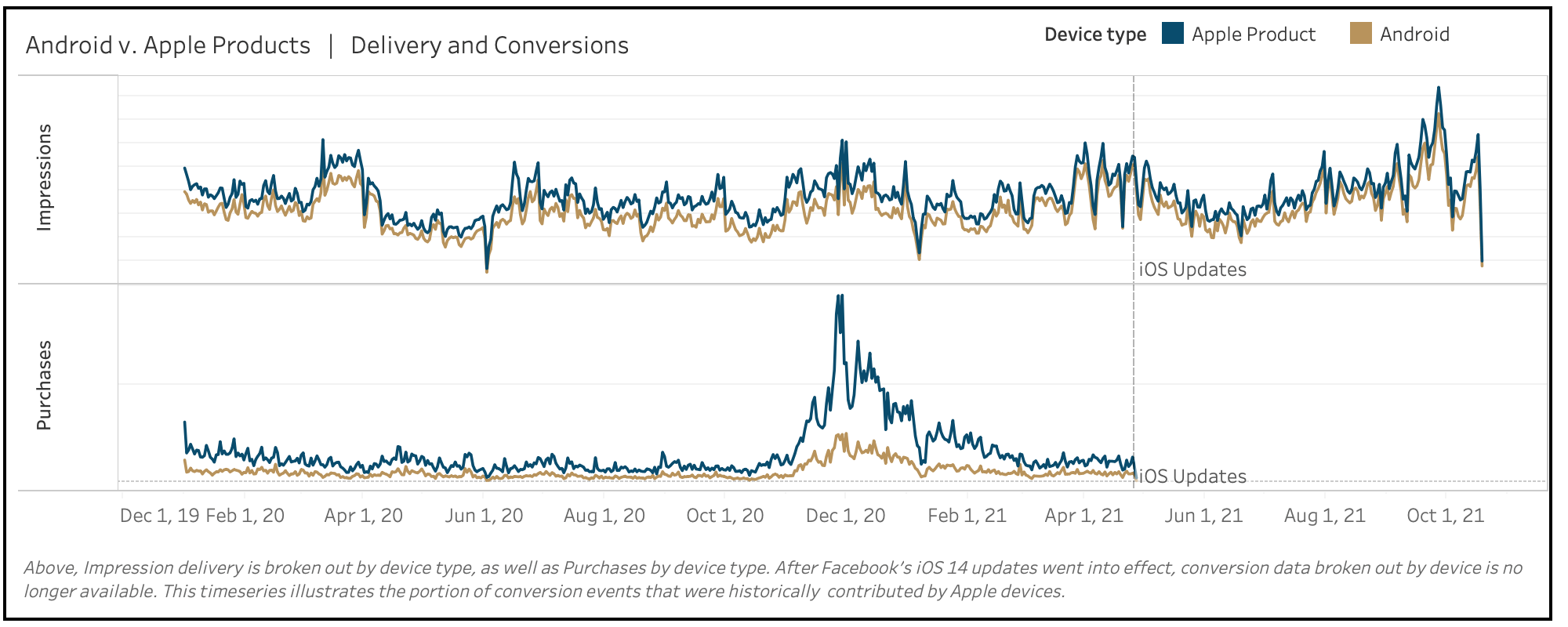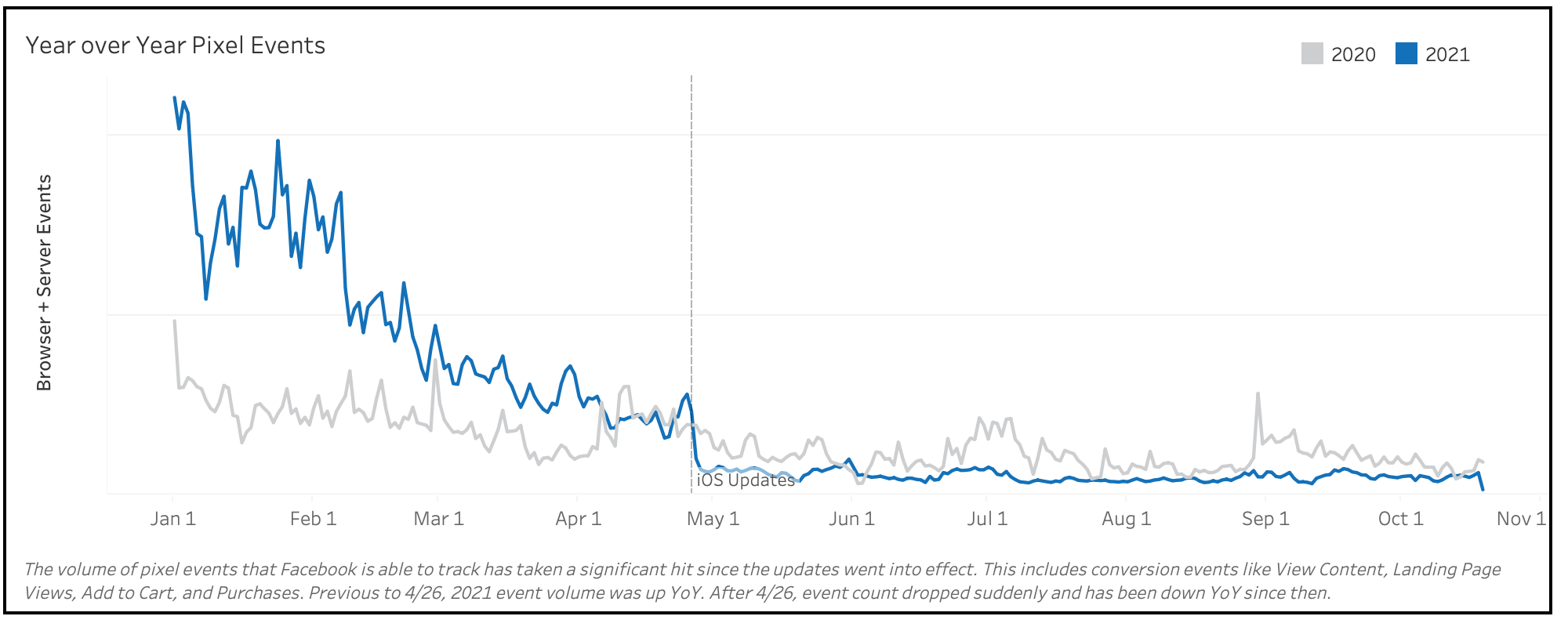iOS14.5 Update: Six Months Later

It’s been six months since Apple rolled out their long-awaited and heavily discussed iOS14.5 update (covered in our original update here). For those who are not aware, the iOS14.5 update contained a major change to the level of control consumers have in how their data is shared across websites and apps. If you use an iPhone you’ve probably seen the prompt: “Allow {Facebook} to track your activity across other companies’ apps and websites?” Unsurprisingly, the majority of U.S. users (estimated at 85% as of September according to Flurry Analytics) have hit “Ask App not to Track” and opted out of sharing their IDFA (Identifier for Advertisers) with Facebook and other apps.
This has been part of a wave of changes in digital advertising aimed at increasing consumer privacy. Consequently, it has impacted paid social performance, strategy, and optimizations, especially within the Facebook platform. As a result, it’s important to understand the effects on campaign targeting, optimization and reporting. After all, Apple users make up more than half of all impressions for Backbone campaigns and have historically (pre-iOS14.5 update) contributed to more conversions than Android.

Targeting
In the world of e-commerce, pixel-based retargeting has been, in some capacity, a critical tactic for almost all advertisers on Facebook. Now that users can opt out of tracking, remarketing audiences have shrunk significantly. Because audience size is also tied to prospecting efforts, budgets, seasonality, and more, measuring the exact decline in audience size is challenging. To combat this, Facebook has introduced their own solution: Conversions API, which is a server-based system for sharing data between e-commerce sites and Facebook. Backbone has found that implementing Conversions API has helped alleviate some of the signal loss, although the impact on stabilizing Facebook performance has been unclear to date.

Optimization
Another impact of the iOS14 updates has been advertisers’ ability to optimize campaigns around specific events. One of the requirements from Facebook is the need for businesses to prioritize their top eight conversion events. For most e-commerce clients, events are organized in a reverse funnel order (purchase, add-to-cart, initiate checkout, view content, landing page view, etc.). This has made it more challenging for us to optimize around lower-priority events like landing page views or view content. Our recommendation to all clients is to closely assess optimization settings, with the consideration that some strategies that worked before the update (optimizing for landing page view vs. traffic, for example) may need to shift based on available data and campaign performance. For clients with smaller budgets, this is particularly important as it relates to attaining enough events to get out of the “learning phase” and allowing the algorithm to work at maximum capacity.
Reporting and Performance
Perhaps the most talked-about impact of the iOS14.5 update has been the impact on reporting and performance. There’s no doubt that we’ve seen a sporadic six months in terms of Facebook results for clients. Not only are results delayed by three days, but results are also now estimated/modeled by Facebook, “unless the campaign is composed of a single ad set and ad.”1 Many reporting elements that used to be standard (conversions by gender, page views by device, etc.) are no longer supported. And the attribution window is much tighter now; one-day view, seven-click window, set as default across the board.
More broadly, the changes discussed above with regards to targeting and decreased audience sizes have had their own (though hard to isolate) impact on performance. We have seen Facebook platform costs (CPM, CPC, CPA) rise in the last six months for clients and are confident iOS14 has played a role in this trend. To illustrate this further, as Facebook has experienced an average decrease of 3 million daily users in the U.S. compared to 2020 (198 million compared to 195 million), they are also reporting a 36% increase in advertising revenue ($13.7 billion compared to $9.2 billion).2 These supply and demand dynamics are resulting in brutal platform competition for advertisers which will likely produce record-high advertising costs throughout the fourth quarter of 2021.
Best Practices Moving Forward
Going forward, we have six key recommendations for clients to assess their campaigns six months after the iOS14.5 update:
- Invest in first-party audiences. Data privacy changes are only going to increase and growing these internal audience pools will be critical to success in the changing digital landscape.
- Use CDP platforms as much as possible. With decreased reliance on pixel-based audiences comes increased reliance on server-based solutions to help move users through a customer journey with optimal reach and frequency.
- Understand how to maximize in-app audiences. Audiences based on actions taken within Facebook/Instagram can also highlight interest and intent (e.g., Facebook/Instagram engagers, video viewers, etc.).
- Test your optimization objectives. A/B test pixel-based objectives based on event prioritization to understand the impacts of signal loss, particularly for campaigns operating with leaner budgets.
- Make sure you’re following all Facebook best practices. Ensure that Conversions API is set up, your domain is verified, and that your events are prioritized in way that will maximize your business goals.
- Consider Facebook performance in comparison to other platforms and channels. While attribution modeling has shrunk in Facebook/Instagram, we’re seeing exciting developments in the way that web actions can be attributed to CTV, podcasts, and more.
More from Facebook here
1 https://www.facebook.com/business/help/331612538028890?id=428636648170202
2 https://s21.q4cdn.com/399680738/files/doc_financials/2021/q2/Q2-2021_Earnings-Presentation.pdf
This report on iOS 14.5 data tracking from Backbone’s digital media team is an update to our previous iOS 14 report. If you have feedback or questions, please send us a note at info@backbonemedia.net.


